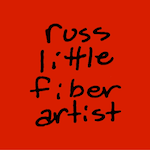
Definitions
Fabric and sewing terms
Rayon: a manufactured fiber created from cellulose. Yes, that sounds gross, but it’s extremely soft to the touch, drapes beautifully, and takes dye extremely well.
Rolled hem: a hand-sewn finish in which the edge of the cloth (e.g., a scarf) is rolled and secured with stitches. Any of my scarves that have a rolled hem started life as an undyed, pre-finished white blank that I purchased from a supplier. I have to be honest: I’ve neither the skill nor the inclination to do this level of hand sewing.
Silk chiffon: a sheer weave that has a texture similar to crepe de chine but finer; a “lighter than air” feeling.
Silk crepe de chine: perhaps one of the most elegant of silk weaves, it has a slightly crinkled texture, drapes beautifully, has a soft hand, and resists wrinkling more than other types of silk.
Silk habotai (aka China silk): a lightweight, plain weave with a soft shiny finish.
Silk organza: a sheer weave with a strong, firm hand. Organza feels like it’s been starched because it retains much of the sericin protein on the silk fiber that is stripped away in other silk fabrics.
Serged seam/edge: seams or fabric edges finished with a serger, a special type of sewing machine that joins fabric and overcast the raw fabric edges at the same time. Edge finishes can be dense flat stitches about 1/4 inch wide or rolled edges about as wide as a bamboo skewer.
Tube scarf: my own term (I think) for a scarf constructed as an open-ended tube. All of the inner seams are surged. The edges of the open ends are surged with a densely stitched flat seam about 1/4 inch wide.
Technical terms
Batik: a resist method in which wax is applied to the cloth to prevent dye, paint, or other chemicals from striking a portion of the cloth. I use soy wax because it has a low melting point, is easily removed from the cloth, and is environmentally safe.
Bound resist: a resist created by clamping, stitching, folding, or binding cloth prior to low-water or full-water immersion dyeing. While I generally refrain from using the term “tie dye”, it is an example of one type of bound resist.
Discharge: to remove dye from cloth through a chemical bleaching process, either oxidation or reduction. Different bleaching agents produce different effects on the cloth. All chlorine bleach products must be neutralized in the cloth to prevent damage to the fiber.
Fiber reactive dye (aka MX dye and Procion dye): a class of dyes that act by forming a strong covalent bond with the fiber. This class of dye works on both protein and cellulose fibers and has good washfast and lightfast properties.
Full-water immersion: a liquid dyeing technique generally used to dye solid colored cloth, but which can also produce subtly mottled effects. This technique requires a larger volume of water than low-water immersion and requires almost continuous agitation to produce a level, solid color.
Low-water immersion: a liquid dyeing technique similar to full-water immersion, but using a minimum amount of liquid and no agitation. The result is a very mottled dyed surface
Monoprint (Monotype): a printing process in which a design is drawn onto a nonabsorbent surface that has been coated with dye, paint, or ink. The object to be printed is pressed into the wet dye and pulled off, taking the dye with it.
Relief print (aka Block print): a printing process in which dye, paint, or ink is applied to a carved block, which is subsequently pressed into contact with the surface to be printed.
Resist: any process that blocks dye, paint, or other chemicals from striking a portion of the cloth, e.g. batik wax or flour paste.
Silk screen: a printing process in which dye, paint, or ink is forced using a squeegee through a screen stretched in a frame. The screen contains a temporary or permanent design that blocks the dye from passing through the screen in some areas, creating a design on the printed surface.
Thickened dye: dye that has been thickened, typically using a material derived from seaweed. Once thick, the dye solution can be used like paint or printing ink.
